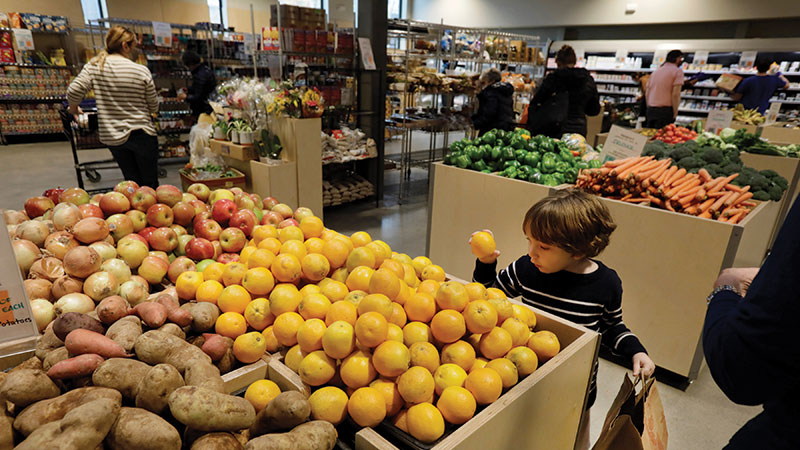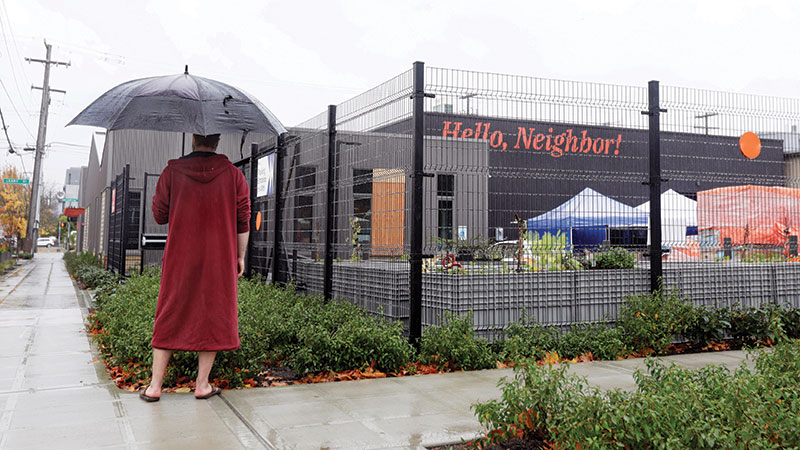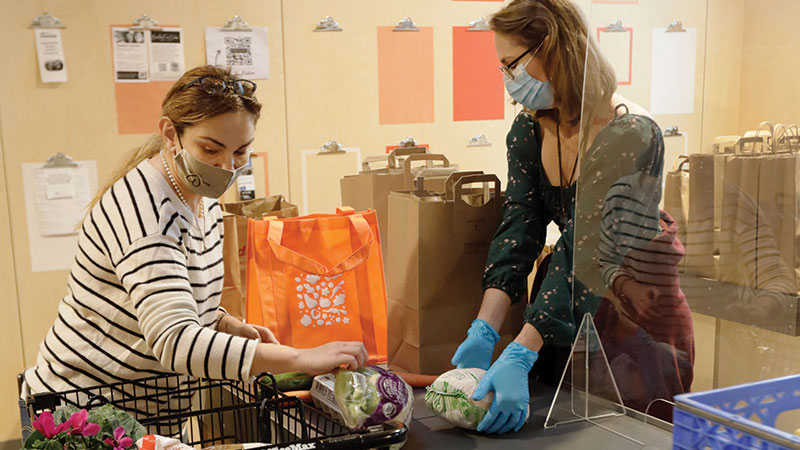Humanity and a grocery “hub for hope”
By Hsiao-Ching Chou, guest contributor, photos by Meryl Schenker
This article was originally published in January 2022

Over time, your favorite grocery store becomes a home and a community. You know the rhythms of the place, the orientation of the aisles, the locations of your favorite items, and you recognize the staff. It’s a relationship. If there’s a disruption—a remodel, perhaps—and what was comfortable and second nature is gone, you feel it to your core.
Now, imagine you’re experiencing a catastrophic life event or series of events and you no longer can afford to shop at your favorite store. If you’ve been in this situation or something similar, then you know. It hurts.
The unmooring of an everyday activity such as grocery shopping reveals how much of an anchor it is. While we sometimes groan about shopping as a chore, it ultimately reflects the relative freedoms and access we gain or lose as we go about our lives.
I’m thinking about this as my fellow board members of the Ballard Food Bank and I continue to celebrate the recent grand opening of the food bank’s new home and community “Hub for Hope.” It took a legion of people several years of effort and a $13.9 million capital campaign to buy the property and build a space that, at 11,000 square feet, is double the size of the previous home.
Among its other advances, the new food bank was deliberately structured in the format of a grocery store and designed with that shopping experience in mind. (PCC staff were among the consultants.) How you experience shopping at a grocery store, after all, is designed. Numerous upstream decisions determine every detail such as what’s displayed at the entrance, the sequence and types of products that follow, the arrangement of produce, the positions of products on the shelves, the interior decor and layout. All of the choices influence your purchasing and send a message about how the store wants you to feel while you’re shopping.
Graham Baba Architects, which designed the new Ballard Food Bank, also designed many of the PCC locations. The intention of the openness, clean lines, skylights, and contemporary interiors of the market space is to offer a sense of calm and hope. Shoppers can select from beautiful displays of fresh produce and meats, dairy and dry goods, household and hygiene products, even bouquets of flowers. Those who need no-cook, halal or kosher foods, or have specific dietary requirements have options, too. Signage is multilingual. Volunteers are available to support those who need accessibility-related accommodations. Everyone who needs food assistance is welcome to shop at the market, regardless of zip code.

The Kindness Cafe, which is adjacent to the market area, serves complimentary sandwiches and hot meals to clients. Those who need additional support, such as assistance with rent, utilities, mail collection, eviction notices, housing, health and wellness, can get help at the food bank’s Community Resource Hub.
Having to get assistance can feel like a commoditized, dehumanizing transaction. But it doesn’t have to be that way. Food assistance, in an ideal world, should be grounded in hospitality and care, and be about the sustenance of life and wellbeing. We want to hold space and welcome our vulnerable neighbors at our community table.
Ballard Food Bank has long believed in providing a grocery store-like experience for its clients—even before moving to the new location. This intentional design choice honors the humanity and dignity of people who happen to need some assistance. Just because people are going through challenging times doesn’t mean they’ve abandoned their sensibilities.
I volunteer as a board member at the food bank because I can’t abide the fact that we have so many neighbors among us who experience food insecurity. Most wrenching for me is knowing there are children at my kids’ schools who don’t have enough to eat. When kids are chronically hungry, they can’t develop and function properly. So the food bank’s Weekend Food for Kids program is especially important to me. WFFK provides vulnerable students a bag containing three dinners, two breakfasts, two lunches and snacks to eat over the weekend.

The pandemic and its associated economic fallout have exacerbated the demand. In the “before times,” Ballard Food Bank had an average of 3,200 visits and deliveries per month. Since the pandemic started, the demand has more than doubled to 7,000 visits and deliveries per month. The numbers continue to rise.
We’ve all experienced a global event that’s reminded us just how quickly our circumstances can change and how crucial human connection is. Ballard Food Bank is the Hub for Hope.
Located on the corner of Northwest Leary Way and 14th Avenue Northwest, Ballard Food Bank is but a few blocks from one of PCC’s newer locations. One has customers and the other has clients. But, at the end of the day, they’re all shoppers.
Hsiao-Ching Chou serves on the board of the Ballard Food Bank. She is the author of two cookbooks, “Chinese Soul Food” and “Vegetarian Chinese Soul Food.”
